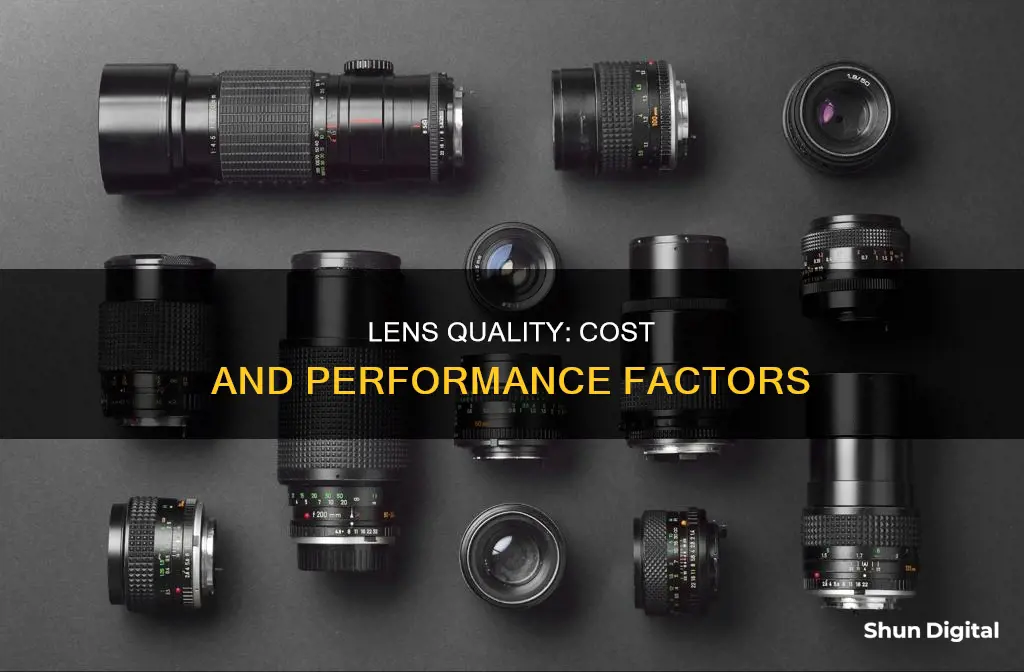
The cost and performance of camera lenses are determined by various factors, including the quality of the lens, the features it offers, the brand name, and the type of photography it is designed for.
Lenses can vary widely in price, from a few dollars to tens of thousands of dollars, and the performance and image quality they offer can differ significantly.
Professional lenses tend to be more expensive due to the high-quality standards and production costs involved. These lenses use high-grade optics, rigorous testing, and hand assembly, resulting in superior image quality, sharpness, and colour reproduction.
The type of photography also plays a role in determining the cost and performance of lenses. For example, lenses designed for wildlife or sports photography may have faster autofocus motors to capture fast-moving subjects, while lenses for everyday photography may not require such advanced features.
Additionally, the brand name of the lens can impact the price, with some brands charging a premium for their products.
When deciding on a lens, it is essential to consider the intended use, budget, and desired features to find the best match for one's needs.
| Characteristics | Values |
|---|---|
| Raw Materials | High-quality glass, aluminum, plastic, magnesium fluoride, silicon monoxide |
| Brand Name | Canon, Nikon, Leica, Sony, Zeiss |
| Production Costs | Hand-crafted, rigorous testing, high-quality standards, complex assembly |
| Research & Development | New technologies, trends, strategies, polling, market research |
| Quality Assurance | High thresholds, complex optical formulas, advanced coatings |
| Performance | Image quality, autofocus, focal length, aperture, image stabilization |
| Features | Weather sealing, lightweight, compact form factor |

Raw materials
High-quality glass is a crucial raw material used in camera lenses. Glass elements are meticulously constructed to control light and form clear, aberration-free images. The glass is calibrated to precise standards, ensuring minimal optical aberration. Additionally, camera lenses often utilise multiple pieces of glass, with each element playing a specific role in focusing light and creating the final image.
Aluminum, brass, and plastic are commonly used in the construction of lens mounts. These materials are die-cast and machined, adding to the overall cost of the lens. Aluminum and brass provide durability and strength to the lens mount, ensuring a secure connection between the lens and the camera body.
Lens coatings are another important aspect of raw materials. Coatings made from magnesium fluoride or silicon monoxide are applied to the glass elements to improve light transmission and reduce flares and ghosts in the final image. These coatings are designed to alter the way the internal glass transmits light, enhancing image quality.
The use of durable metals, advanced composites, and weather-resistant coatings in high-end camera lenses also contributes to their cost. These materials offer increased durability, resistance to wear and tear, and protection from external elements such as dust, moisture, and extreme temperatures.
The quality of raw materials used in camera lenses directly impacts their performance. Lenses made with high-quality materials often provide sharper images, better colour accuracy, and improved overall image quality. Additionally, the use of advanced materials can enhance the lens's durability, ensuring a longer lifespan and resistance to damage from everyday use.
In summary, the raw materials used in camera lenses significantly influence their cost and performance. High-quality glass, precision-calibrated to minimise aberrations, is essential for clear image formation. Aluminum, brass, and plastic provide sturdy lens mounts, while coatings made from magnesium fluoride or silicon monoxide enhance light transmission and reduce unwanted flares. The use of durable metals and advanced composites in high-end lenses justifies their higher price tags and contributes to their overall performance and longevity.
Best Camera Bag for Sony a6000 and Lenses
You may want to see also

Brand name
The brand name of a camera lens can have a significant impact on its cost and performance. While it is essential to consider other factors, such as lens type, specifications, and features, the brand name often signifies certain standards and qualities associated with the manufacturer.
Quality and Performance:
Innovation and Specialisation:
Reputable brands are often at the forefront of innovation, incorporating cutting-edge technologies and features into their lenses. For example, Canon's "L" series lenses are known for their exceptional quality, while Sony's G Master lenses are sought after for their sharpness and bokeh quality. Additionally, brands may specialise in certain types of lenses, such as Leica's handcrafted lenses or Zeiss's exotic and special-purpose lenses, which command a higher price due to their unique characteristics.
Reliability and Support:
Brand-name lenses often come with a certain level of reliability and after-sales support. Established brands have a reputation to uphold, so they focus on delivering consistent quality and providing comprehensive customer service. This includes offering warranties, repairs, and technical assistance, ensuring that customers can rely on their products and receive help when needed.
Market Presence and Availability:
Well-known brands typically have a more extensive market presence and distribution network, making their lenses more readily available to consumers. This availability can be crucial for photographers who need quick access to specific lenses or require a wide range of options to choose from.
Resale Value and Longevity:
Lenses from reputable brands tend to hold their value better over time, making them a more sustainable investment. Photographers may also find it easier to resell or trade-in brand-name lenses due to their recognised quality and performance. Additionally, established brands are more likely to provide long-term support and compatibility for their lenses, ensuring they can be used with newer camera bodies.
While brand names play a significant role in the cost and performance of camera lenses, it's important to remember that the specific features, specifications, and user needs should always be the primary considerations when making a purchase decision. Different brands may excel in various aspects, so it's essential to research and compare options to find the best lens for your requirements.
Choosing Camera Lenses: A Guide to Shopping for Beginners
You may want to see also

Research and development
The R&D department also plays a key role in testing and quality assurance, which is rigorous and extensive for professional-grade lenses. This includes testing and inspecting the glass elements used in the lenses, which are hand-pressed, shaped and handled by experienced engineers. They run both visual and computerised inspections to detect any potential problems. The complex optical design of professional lenses requires many optical elements to reduce or correct various lens aberrations, which adds to the cost.
In addition to the R&D costs, the production of camera lenses is also labour-intensive and can involve hundreds of engineers and craftsmen. These skilled workers assemble the lens elements by hand, which is a time-consuming and costly process. They also use expensive machinery to speed up production and handle complex tasks. The cost of hiring these skilled workers adds significantly to the overall price of the lenses.
Furthermore, manufacturers also incur costs for sales and marketing personnel, as well as digital advertising and print media. Introducing their camera lenses as the best or fastest on the market requires significant investment in advertising and contributes to the high price tag of the final product.
Capturing Sports: Camera Lens Techniques for Dynamic Shots
You may want to see also

Production costs
The production costs of camera lenses can vary significantly, depending on factors such as the quality of materials used, the level of human involvement in manufacturing, and the complexity of the lens design.
Materials
The raw materials used in constructing camera lenses are a major factor in determining their production costs. High-quality glass, aluminium, plastic, and magnesium fluoride or silicon monoxide are all expensive to acquire and assemble. Additionally, the glass must be calibrated to exacting standards to produce clear images with minimal aberration.
Human Involvement
The level of human involvement in the manufacturing process also affects costs. Professional-grade lenses often require rigorous testing and inspection of each glass element by experienced engineers, which increases labour costs. The assembly process for these lenses may also be done by hand, further raising production costs. In contrast, consumer-grade lenses are typically manufactured in batches with minimal human involvement, resulting in lower costs.
Design Complexity
The complex construction and design of camera lenses also contribute to their production costs. A single lens may contain several glass elements of varying sizes and shapes, each meticulously constructed to control light and form an image. The mount that connects the lens to the camera body also has a unique construction to ensure compatibility. Additionally, the exterior of the lens must be durable enough to withstand everyday use, and some lenses even offer weather sealing for resistance against outdoor elements.
Mounting Still Lenses: PL-Mount Cinema Camera Compatibility
You may want to see also

Quality assurance
Firstly, the quality of the raw materials used plays a significant role. High-end lenses use high-quality glass, aluminium, and sometimes brass components, which are more expensive and require advanced manufacturing techniques. The glass, in particular, is calibrated to exacting standards to produce a clear image with minimal aberration.
Secondly, the design and construction of the lens are crucial. A complex arrangement of glass elements of varying sizes and shapes must be meticulously constructed to control light and form an image. The mount that connects the lens to the camera body also has a unique construction to ensure compatibility. Weather sealing is another important feature, protecting the lens from dust, water, and other elements.
Thirdly, the quality of the assembly process is vital. In cheaper lenses, most of the assembly is done by machines, whereas high-end lenses are often hand-assembled by skilled engineers, ensuring a higher level of precision.
Finally, extensive testing and quality checks are necessary to ensure the lens functions as intended. High-end lenses have much tighter quality thresholds than cheaper lenses, and both visual and computerized inspections are carried out to detect any potential issues.
In summary, the quality of a camera lens is determined by the quality of the materials used, the precision of the design and construction, the assembly process, and the rigour of the testing and quality assurance procedures.
Traveling with Camera Lenses: A Comprehensive Guide for Photographers
You may want to see also
Frequently asked questions
Camera lenses are expensive due to the high cost of the raw materials used, the brand name, and the amount of human involvement in the manufacturing and testing process.
Expensive camera lenses offer better construction, image quality, and features than their cheaper counterparts. They can help capture extremely sharp and detailed photos. However, the price of a lens does not always guarantee better results and sometimes, a cheaper lens might be more suitable for certain photography needs.
For amateur photographers, it is recommended to go for something that gives decent performance at an affordable price. Casual photographers can opt for a standard zoom lens, which is inexpensive and produces decent-quality images. Professionals should invest in the best lens they can afford as it will pay for itself in the long run.







